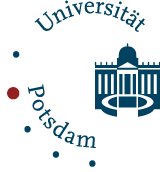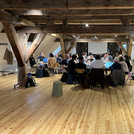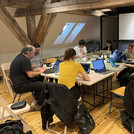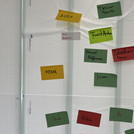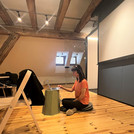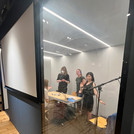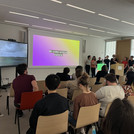Repurposing Forest Media
What is the project about?
Soundscapes project
How can soundscapes be used as a way to attend to forest life and the many different ways of narrating and relating to forests, forest issues and forest protection and restoration efforts?
The forestscapes project aims to explore and document generative arts-based methods for recomposing collections of sound materials to support “collective inquiry” into forests as living cultural landscapes.
Video recomposition project
Forest restoration theme background
Digital media and technologies are increasingly participating in reshaping the role of forests in society and environmental politics (Schneider & Olman, 2020; Gabrys et al., 2022). They also play a role in “infrastructuring public participation” in forest and ecological politics (Marres, 2022), as forest-society relations are increasingly articulated in and through the web, social media, apps and online platforms.
In this context, this project seeks to explore the politics of forest restoration as a climate change solution by taking digital media as a site of inquiry. More specifically it aims to explore how arts-based media repurposing and recomposing techniques can be used to examine, situate and critique accounts of forest restoration that gain visibility algorithmically on platforms, as well as to create opportunities for resistance and recomposition of forest restoration ecologies.
What is your research question?
General
- How can forest related media be repurposed for collective inquiry into ecological politics?
- How can critical, arts-based media repurposing approaches be used to explore ecological politics?
- How can media recomposition help to both critique problematic projects as well as to open up other perspectives on ecological politics?
Soundscapes project
- How can soundscapes be used as a way to attend to forest life and the many different ways of narrating and relating to forests, forest issues and forest protection and restoration efforts?
- How can generative soundscaping techniques be used to explore forest restoration practices and politics?
Video recomposition project
- How can video recomposition techniques be used to explore the politics of forest restoration on YouTube?
- Which animals, plants, and other non-human entities receive more attention in forest-related media?
- How can video supercuts and other video recomposition techniques be used to develop critiques of forest restoration practices associated with various actors over time: corporations, government, NGOs, etc., along particular lines of inquiry:
- How nature is performed in forest restoration videos (and what biases and absences are produced by Youtube’s ranking algorithms))
- How society is performed (and what stories about society are told)
- How technology is performed
- How numbers, graphs and dashboards are put to work in forest restoration video
- What would feminist decolonial approaches to caring for forests look like?
- Are there video types / scene types showing forest restoration practices and politics that could be surfaced through supercut techniques?
- Can we develop new methods/ approaches for recomposing video material in context of collective inquiries into ecological politics?
- How can video recomposition techniques be used to explore politics of nature based solutions and role of forest restoration in corporate greenwashing?
- How can online materials be repurposed to attend to extractive, colonial dynamics of forest restoration work (and possible alternatives)?
- Who participates in/engages with ecological restoration efforts (in different sites)?
- How, and by whom, is ‘restored nature’ imagined? What does it look like/sound like in different places? Which entities (species/plants) are visible?
- Can we map/identify different restoration narratives? And areas of tensions/controversies?
- What would an AI restored forest look like?
- How does carbon accounting remake the forest and what methodologies exist in the offset space for this?
- How do we shape and spotlight counter-narratives to challenge the systemic powers determining public climate understandings in relation to intersectional climate justice?
- How do we play with timelines of change?
- How do we redefine (or add definitions to) what constitutes 'climate data' in light of sound and visuals-based information for communal climate knowledges?
References and links
What methods, data sets, and tools are used?
Soundscapes project
Data sets
- Forest sound collections (e.g. field recordings from QEFP - Scottish restoration site; sounds from Youtube)
Video recomposition project
Data sets
- BP Video Library (https://www.bpvideolibrary.com/) - a collection of videos created by BP, from 1921 to 2020.
- List of most viewed videos returned by YouTube for forest restoration-related keywords in English and Italian
- Archive of all US carbon offset projects
What do you expect to be the outcome of the Hackathon for your project?
Before event
- Gather and curate site-based and topic-based media collections of sounds and videos
- Share package of materials, readings and tools
At event
- Prototype and reflect on forest sound works with online media
- Prototype and reflect on forest video works with online media
- Prototype software and approaches for repurposing online sound and video
- Explore, discuss and conceptualise online video as test site for forest politics
- Explore possible longer term projects and collaborations
After event
- Document outputs, software and approaches (e.g. zine? blog post?)
- Possibility to share outputs at re:publica Berlin 2023
Video recomposition project
Envisioned outputs
- Designing and testing co-inquiry and recomposition protocols
- Prototype video composites
- Designing computational collages starting from video materials (something like this: https://lucadra.github.io/itematlas/); outputs that foreground a hierarchy of non-human entities in (urban) forest-related video materials, applying the notion of climate change issue animals to (urban) forest media, building on the claim that “on social media, digital encounters most commonly occur with familiar species, involving spectacular, stereotypical, and repetitive representations (Turnbull et al., 2022)”. More recently, a similar approach has been explored with Wikipedia data.
Who is part of the team?
Soundscapes project
- Maud Borie (she/her) in relation to work on nature-based solutions and forestscapes
- Andrés Saenz de Sicilia (he/him) in relation to work on listening to forests and forestscapes
- Angela YT Chan (she/her) in relation to art-based research on climate change
- Jonathan Gray (he/him) in relation to work on listening to forests, forestscapes, nature-based solutions and forest media practices
Video recomposition project
- Jonathan Gray (he/him) in relation to work on listening to forests, forestscapes, nature-based solutions and forest media practices
- Liliana Bounegru (she/her) in relation to work on listening to forests and forest media practices
- Gabriele Colombo (he/him) in relation to work on forest media practices and working with image collections
- Sam Lavigne (he/him) in relation to work on videogrep and carbon offsets
- Tega Brain (she/her) in relation to work on carbon offsets, coin operated wetlands and environmental management
